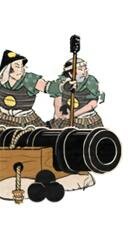
Basic Unit Statistics
| Recruitment Cost | 800 | |
| Upkeep Cost | 75 | |
| Melee Attack | 2 | 6% |
| Charge Bonus | 5 | 14% |
| Bonus vs Cavalry | 0 | 0% |
| Range | 500 | 76% |
| Accuracy | 60 | 66% |
| Reloading Skill | 40 | 44% |
| Ammunition | 10 | 20% |
| Melee Defence | 1 | 2% |
| Armour | 1 | 12% |
| Morale | 2 | 5% |
| Speed | 4 | 33% |
Strengths & Weaknesses
- Armed with weapons designed for dealing with castles and buildings.
- Vulnerable to cavalry and in melee in general.
Requirements
Description
These guns are carefully deployed at the start of a battle. They must be well defended, as the gun crew is few and vulnerable. European cannons are slow to fire and relatively inaccurate, but this matters not a jot when the target is as large as a castle wall! Once in place, they have a long range and do great damage to defensive structures. The Sengoku Jidai marked a massive shift in the pattern of Japanese warfare. Previously, warfare had been a matter of single combat between samurai, but increases in the size of armies and battles along with the introduction of gunpowder meant that daimyo needed to embrace modern warfare tactics to survive. In 1543, the Japanese had their first contact with the Portuguese, who soon established the ‘nanban’ trade, providing the Japanese with arquebuses and cannons. Tokugawa Ieyasu used such cannons when he won the siege of Osaka, indisputably establishing himself as shogun. Ironically, it was Ieyasu’s grandson, Tokugawa Iemitsu, who put an end to the trade when his ‘sakoku’ policy stopped all foreigners from entering Japan and closed the country until 1853.
